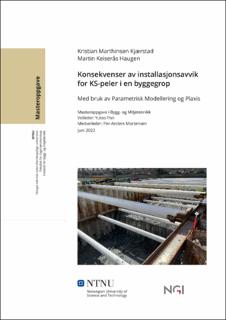| dc.contributor.advisor | Pan, Yutao | |
| dc.contributor.advisor | Mortensen, Per-Anders | |
| dc.contributor.author | Kjærstad, Kristian Marthinsen | |
| dc.contributor.author | Haugen, Martin Keiserås | |
| dc.date.accessioned | 2022-10-04T17:19:50Z | |
| dc.date.available | 2022-10-04T17:19:50Z | |
| dc.date.issued | 2022 | |
| dc.identifier | no.ntnu:inspera:116344653:21804067 | |
| dc.identifier.uri | https://hdl.handle.net/11250/3023706 | |
| dc.description.abstract | I Drammen skal Bane NOR bygge dobbeltsporet jernbane fra Drammen til Kobbervikdalen. Veidekke AS er totalentreprenør på delentreprisen UDK02 Kulvert og løsmassetunnel. NGI er rådgivende geotekniker for prosjektet og har prosjektert en byggegrop med innvendige stivere og KS-stabilisering i passiv sone. Ved installasjonen av KS-pelene har utførelsen blitt dokumentert med hensyn til GPS-koordinater og utsatt pellengde. Denne masteroppgaven skal undersøke hvordan installasjonsavvikene påvirker KS-ribbene sin konstruktive effekt, og etablere partialfaktorer som kan anvendes i fremtidig prosjektering for å inkludere disse avvikseffektene. Et modelloppsett med beregningsfaser og jordmodeller som repliserer prosjekteringen fastsettes og anvendes i samtlige analyser.
Beregningsprinsipper for å inkludere KS-stabiliseringens materialfasthet betraktes i den innledende analysen med hensyn til håndberegninger, Plaxis 2D og Plaxis 3D. Resultatenes forskjeller diskuteres med hensyn til stiverkrefter, sikkerhetsfaktor for materialfastheten og spuntens maksimale skjærkraft, bøyemoment og horisontalforskyvning. De forskjellige mesh-kvalitetene Plaxis tilbyr undersøkes, og et minimumskrav fastsettes til hovedanalysen som skal inkludere installasjonsavvik.
Det har blitt tildelt sannsynlighetsfordelinger til hver avviksparameter basert på innmålte installasjonsdata fra UDK02. Avviksparameterne utgjør ansett, asimut, pelhelning og lengdeavvik. KS-ribber med avvik etableres ved hjelp av parametrisk modellering, som eksporteres til Plaxis for beregningsfasene. Hovedanalysen tar for seg installasjonsavvikene og undersøker hvordan de påvirker KS-ribbene.
Konverteringen fra Plaxis 3D med installasjonsavvik til Plaxis 3D med KS-ribber som rektangulære prismer, gjøres ved å anvende partialfaktorer i størrelsesorden 1,000-1,362, avhengig av byggegropens komponent. Dette gjelder for basistilfellet og studiet om endret modellgeometri. KS-ribber med ekstreme avvik lik 95\%-persentilene fra sannsynlighetsfordelingene overgår maksimal verdi for disse simuleringene, som bekrefter at et økt antall simuleringer er nødvendig for å oppnå verst mulig kombinasjon av installasjonsavvik. Den mest kritiske modellparameteren er utgravingsdybden, der en økning i dybden på 2 m fra basistilfellet resulterer i eksempelvis en partialfaktor lik 3,5 for spuntens horisontalforskyvning. Resultatet fra analysen om lastoverføring viser at økte installasjonsavvik vil gi økt kompressibilitet og økte horisontalforskyvninger. Spenningskonsentrasjonene langs ribben vil også variere i en større grad ved installasjonsavvik.
Installasjonsavvik har en betydelig effekt på resultatene og kan utgjøre titalls prosent forskjell, sammenlignet med uten avvik. Forskjellene mellom å modellere i 2D og 3D er signifikant, da forskjeller på 400% er bekreftet. Håndberegninger for det statisk ubestemte systemet er upålitelige og ulike programvarer anbefales benyttet. Installasjonsavvikenes effekter er lite forsket på og oppgaven konkluderer med at fremtidig prosjektering må inkludere en større sikkerhet enn hva som er dagens tilfelle. | |
| dc.description.abstract | In Drammen, Bane NOR are going to construct a double-track railway from Drammen to Kobbervikdalen. Veidekke AS are the overall contractor for the subcontract of UDK02 Culvert and loosematerial-tunnel. NGI are the geotechnical engineers for the project and have dimensioned an excavation pit with struts and deep mixing panels for the passive zone. The installation process have been documented for the lime-cement columns regarding GPS-coordinates and the length of the columns. This master thesis are investigating how the geometrical imperfections affects the lime-cement panels and establishes partial factors which can be included in future projects to take into account installation errors. A model setup with calculation phases and soil models are established to replicate the project and are implemented in all of the analysis.
Calculation principles to include the strength of stabilization by lime-cement are considered in the initial analysis by introducing hand calculations, Plaxis 2D and Plaxis 3D. The difference of the results are discussed regarding strut forces, safety factor and the bending moment, shear force and horizontal displacement for the retaining wall. Different mesh-types in Plaxis are put to test and minimum requirements are determined for the main analysis, which includes the geometrical imperfections.
Probability distributions have been allocated to each parameter of the geometrical imperfections, based on data from UDK02. The parameters are offset, azimuth, length of the column and length deviation. Panels with these errors are constructed with parametric modelling, which are exported to Plaxis for the calculation steps. The main analysis does include geometrical imperfections and investigates how these affects the stabilization method.
Convertion from Plaxis 3D with installation errors to Plaxis 3D with panels of rectangular prisms can be done by utilizing partial factors in the range of 1,000-1,362, depending on the excavation pits component. This is applicable for the basis model setup and the study of varied model geometry. The panels regarding the 95\%-percentiles from the probability distributions exceeds the maximum value from these simulations, which confirms that an increase in simulations are necessary to establish a panel with maximum installation errors. The most critical model geometry is the excavation depth, where an increase in depth by 2 meters results in a partial factor of 3,5 for the horizontal displacement of the retaining wall. The result from the investigation of the load transfer shows an increased compressability and displacement when the geometrical imperfections increases. The stresses through the panels varies in a larger extent when geometrical imperfections are included.
Installation errors have a significant effect on the results and can increase forces and displacements by tens of percents, compared to no imperfections. The difference of modelling in 2D and 3D are also significant, where differences of 400% are confirmed. Hand calculations for the statistical undetermined system are doubtful and implementing different software-programs are recommended. The phenomenon of geometrical imperfections is not studied to a large extent and this thesis concludes that future projects must include larger safety than what is included until now. | |
| dc.language | nob | |
| dc.publisher | NTNU | |
| dc.title | Konsekvenser av installasjonsavvik for KS-peler i en byggegrop | |
| dc.type | Master thesis | |
